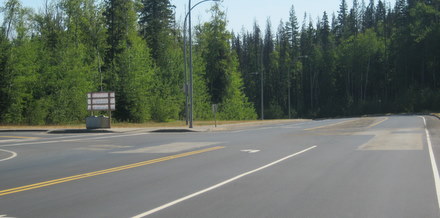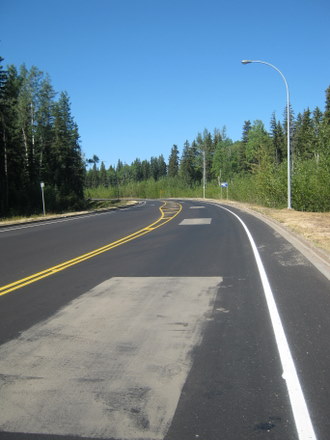'Patches' In New Paving

Re-oiled areas in new paving at UNBC turn-off, looking eastbound on University Way
Prince George, B.C. - It looks like there are already patches in some of the City's capital roadwork projects completed this summer...
Travelling westbound, towards UNBC, along the newly-paved three-kilometre stretch of University Way, there are numerous brown, rectangular 'patches' in the asphalt.
The City's Technical Services Supervisor, Mick Jones, says, there were some areas of the new pavement that looked "more open" than the rest of the road, so asphalt oil was painted in to seal the spots, and they were covered with sand to prevent vehicle tracking, giving the spots a discoloured look. "What the oil will do is prevent water from sitting in any cavities that aren't smooth and tight -- so, basically, it's to seal it better -- but longterm, there should be no ill-effects of those patches."
 The City of Prince George completed a record $3.4-million dollars worth of road rehabilitation projects this year, tacking on an extra one after coming in slightly under-budget in late July. (click here, for previous story) And Jones admits there have been more problem spots than in previous years. "We've had conversations with the contractor as to potential causes of it and there's no one cause, it may be a combination of activities along the asphalt making/handling/and placing process."
The City of Prince George completed a record $3.4-million dollars worth of road rehabilitation projects this year, tacking on an extra one after coming in slightly under-budget in late July. (click here, for previous story) And Jones admits there have been more problem spots than in previous years. "We've had conversations with the contractor as to potential causes of it and there's no one cause, it may be a combination of activities along the asphalt making/handling/and placing process."
He says it may be a production issue, "It just gets to an area where there might have been a little less sand in the asphalt mix and maybe a little more rock."
"It could come back to workmanship, or handling, or how it was process -- we continue to monitor it," says the Technical Services Supervisor.
"It's one of those things that you don't see at time of (asphalt) placement, but we do a follow-up walk once the road is completed and we can identify any areas that might be deficient."
One thing that is for certain, any costs associated with fixing the problem areas, and all warranty work, are born by the contractor. The City has a 'one-year test period' built into all capital works projects.
Jones says all summer roadworks are typically assessed the following spring. "With our aggressive sanding materials, it's more likely to do some potential damage to the road, so we like to see how they 'wintered' and make sure they're not showing early signs of failure."
Previous Story - Next Story
Return to Home









